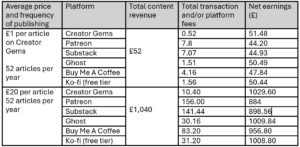Imagine spending three years building your dream home, only to learn the land is rented and the owner plans to sell. You would never do that with a house, yet millions of creators do it with their businesses.
Take Sarah. She had 850,000 TikTok followers, videos in the millions, and £8,000 a month in income. An overnight algorithm change cut her reach by 80 percent; within three months she was at £1,200. Sarah is fictional, but her story is common.
Research with 1,624 creators from #independentcreator found 77% worry about relying on social platforms for earnings and 70% say an algorithm dip could have “serious effects” on their life.
This is the reality for creators who built on platforms they do not control. They built empires on rented land and are now paying the price.
Investing time, effort and resources into platforms – aka ‘Rented Land’
When you build your creator business primarily on social media platforms, you’re essentially renting digital space. The narrative is like renting physical property where you don’t own the infrastructure. The platform owns your audience data, controls your reach, and sets the rules.
Since the “land” isn’t yours, you’re paying rent through revenue sharing: platforms take substantial portions of your earnings whilst providing the “space”. This brings operational risks such as algorithm changes, policy updates, or account suspensions that can eliminate years of your work instantly. Platform objectives are maximising their profits and their shareholders’ benefits; you are just a content generator for them.
This narrative of rented land describes the economic relationship, or value exchange. You’re building something valuable on someone else’s property, under their terms, with no guarantee of continuity.
Platforms should function as discovery tools that drive traffic to your owned properties, not as your primary business location. Use them strategically, not dependently.
Why the shift to “Owned Digital Infrastructure” aka “Owned Land” is accelerating
The transition from rented to owned digital infrastructure requires planning, but the fundamental steps are straightforward. Start with a solid foundation, build genuine audience relationships, and create direct value exchange mechanisms.
Owned land is a trend that is growing. Platform organic reach is steadily declining. Documented research shows Facebook’s organic reach dropped from 16% in 2012 to less than 2% by 2022, whilst Instagram’s organic reach averages 1.9%. Such dramatic drops in organic reach are, of course, done on purpose to limit content visibility and encourage advertising spend. Again, the landlord is maximising profit from their assets.
Here are the statistics on how much revenue is retained by social platforms. There’s not much left for creators. Here are a few examples: YouTube retains 45% of ad revenue. TikTok’s Creator Fund pays approximately £0.02-£0.04 per 1,000 views, which makes it between £20-£40 per million. On Instagram, monetisation delivers unpredictable and often declining payouts, whilst Patreon charges 5-12% platform fees plus payment processing costs.
All these algorithm changes, of course, come unannounced, causing unpredictable income fluctuations caused by algorithm changes, platform policy updates, technical issues, or account restrictions that halt revenue immediately.
Owned digital infrastructure represents assets you control completely. These include your own website with your own payment system and your own email list. The email list presents you with a direct communication channel with your customer database that has the highest industry ROI, with the average ROI of £36 for every £1 spent or even £44 for large businesses.
Having your digital business set up this way gives you more financial control. You retain up to 99% of your revenue instead of losing substantial portions to platform fees. A 1% transaction fee versus 12-18% combined platform and processing fees represents a 1,400% cost difference.
Let’s break it down.

Ready to own digital land?
Direct monetisation has been hard for creators because of high fees, complex setup and payout thresholds. That is changing. Modern micropayments make it viable to charge small amounts for individual pieces.
We can help you monetise your content more intelligently on your own digital land. This can be done by setting up a Fourdotpay wallet on your website for pay-per-article content monetisation, which is a non-technical solution that can be implemented in a few minutes. Another non-techie developed by Fourdotpay is Creator Gems, which is a creative hub where creators can monetise their content. Both solutions charge only a 1% transaction fee.
Fourdotpay offers a wallet for payments up to £20 with a 1% fee. Use it on your own site or via our Creator Gems hub to sell pay-per-article content. Research shows many readers prefer one-off payments to subscriptions, even when a subscription looks cheaper, because they want control and less fatigue.
With simple tools and low fees, creators can earn directly from their audiences at scale. Value moves straight from reader to creator, not through a platform first.
Your creative work deserves to benefit you, not just the platforms that host it.
